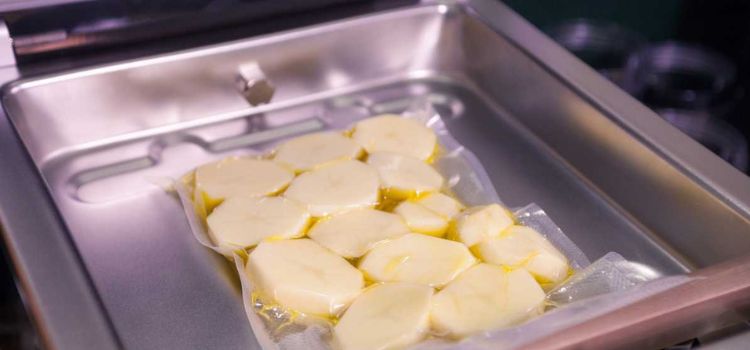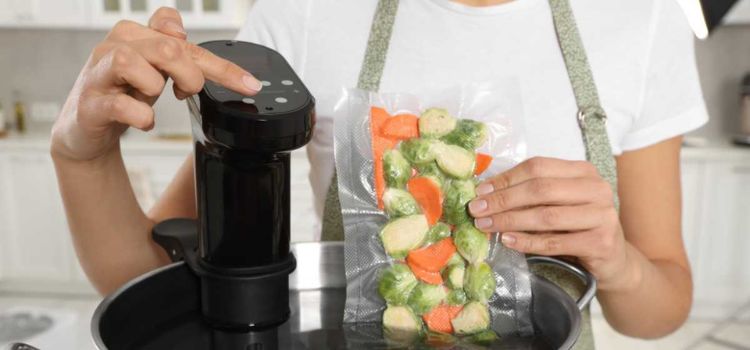As an Amazon Associate, I earn from qualifying purchases

Vacuum sealing has become a popular method for preserving food and maintaining freshness. This technique involves removing air from a bag to create a tight seal around the food, which helps extend its shelf life and protect it from freezer burn.
Commonly used for storing meats, vegetables, and other perishables, vacuum sealing is a staple in many kitchens. However, beyond storage, vacuum-sealed bags have found a place in the culinary world through methods like sous vide cooking, where food is cooked in a precisely controlled water bath. This raises the question: Can you boil vacuum-sealed bags?
The Concept of Boiling Vacuum-Sealed Bags
The idea of boiling vacuum-sealed bags might sound unconventional at first, but it’s actually integral to a cooking method known as sous vide. Sous vide, which means “under vacuum” in French, involves vacuum-sealing food in a bag and cooking it to a very precise temperature in a water bath. This method ensures even cooking without overcooking, and it’s particularly beloved for its ability to enhance flavors and textures.
Boiling vacuum-sealed bags allows for a controlled cooking environment where the food can cook evenly and retain its natural moisture. This technique is beneficial for meats, as it can break down connective tissues at lower temperatures than traditional methods, resulting in a tender and juicy product. Moreover, the vacuum-sealed environment helps infuse flavors into the food, making it a popular choice for gourmet cooking.
Safety Considerations
While boiling vacuum-sealed bags can yield delicious results, safety is paramount. The first consideration is to ensure that the materials used are food-safe and designed to withstand high temperatures. Not all vacuum-sealed bags are created equal, and using the wrong type could result in melting or leaching of harmful chemicals into the food.
Potential risks include bag rupture due to pressure build-up or using materials not meant for high heat. To mitigate these risks, always check the manufacturer’s guidelines to ensure the bags are boil-safe. It’s also a good idea to avoid overfilling bags, as this can increase pressure and the risk of rupture when heated.
Types of Bags Suitable for Boiling
- Boil-Safe Vacuum-Sealed Bags: These bags are specifically designed to handle high temperatures without breaking down. They have a higher heat tolerance and are made from materials that don’t impart flavors or chemicals into food.
- Material Composition: Boil-safe bags are often crafted from polyethylene and nylon, ensuring durability and stability during boiling.
- Regular Vacuum-Sealed Bags: While suitable for storage, these bags may fail under boiling conditions, risking food safety and quality.
- Key Consideration: Always use boil-safe bags when cooking to maintain safety and ensure the integrity of your food.
Benefits of Boiling Vacuum-Sealed Bags

Benefits of Boiling Vacuum-Sealed Bags (Sous Vide)
- Enhanced Flavor Infusion: The vacuum-sealed environment allows seasonings and marinades to penetrate deeply into the food, resulting in rich, well-developed flavors that elevate the overall dish.
- Precise Cooking: Maintaining a consistent temperature ensures perfect doneness for various foods, such as steak, chicken, or vegetables. This level of precision is challenging to achieve with traditional cooking methods, making sous vide a preferred technique for both chefs and home cooks.
- Nutrient Preservation: Cooking at lower temperatures helps retain vitamins and minerals that can be lost through traditional high-heat methods. This approach not only safeguards the nutritional value of the food but also maintains its natural texture and moisture.
Conclusion
Boiling vacuum-sealed bags offers a unique and effective way to prepare food, combining the benefits of flavor infusion, precise cooking, and nutrient preservation. Whether you’re an experienced chef or a home cook looking to experiment, this method opens up a world of culinary possibilities. However, it’s crucial to prioritize safety by using the appropriate bags designed for high-temperature cooking.
In summary, the art of boiling vacuum-sealed bags, particularly through sous vide cooking, provides an innovative approach to food preparation that is both versatile and rewarding. By understanding the key benefits and adhering to safety guidelines, you can explore this method with confidence and creativity. Embrace the technique and discover the delicious potential of your vacuum-sealed culinary creations.
FAQ
Is it safe to boil vacuum seal bags?
Yes, it’s safe to boil vacuum seal bags if they’re designed for high temperatures. Use boil-safe bags made from food-grade materials to prevent melting and chemical leaching. Always check the manufacturer’s guidelines to ensure the bags are suitable for boiling or high-heat cooking.
Can you heat food in vacuum sealed bags?
You can heat food in vacuum sealed bags using methods like sous vide, where precise temperature control ensures even heating. Ensure the bags are heat-safe and food-grade to avoid damage or contamination. This method helps retain moisture and flavor while evenly cooking the food.
Can you cook in a vacuum sealed bag in water?
Yes, cooking in a vacuum sealed bag using the sous vide method is popular. This technique involves submerging the sealed bag in water at a controlled temperature, ensuring precise and even cooking. Use bags specifically designed for heat exposure to maintain food safety and quality.
As an Amazon Associate, I earn from qualifying purchases